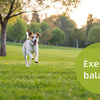Can Dogs Get Too Much Exercise? Understanding the Balance for Your Furry Friend
- Houndsy
Table of Contents
- Introduction
- The Importance of Exercise for Dogs
- Signs Your Dog Might Be Over-Exercising
- Finding the Right Balance: Exercise and Enrichment
- Conclusion
- FAQ
Introduction
Did you know that nearly 50% of dogs in the United States are considered overweight or obese? This alarming statistic highlights the growing concern among pet owners about the importance of regular exercise for our furry companions. However, as dedicated pet lovers, we often find ourselves wondering: can dogs get too much exercise? The answer is not as straightforward as it seems.
In this blog post, we aim to explore the nuances of canine exercise, including the benefits of physical activity, the risks associated with over-exercising, and how to strike the perfect balance for our dogs. By the end of this post, you will have a deeper understanding of your dog's exercise needs, learn how to recognize signs of over-exertion, and find ways to enrich their daily routines. So, grab a cup of your favorite beverage and let’s dive into the world of canine fitness!
The Importance of Exercise for Dogs
Exercise is essential for the overall well-being of our dogs. It helps maintain a healthy weight, keeps joints limber, and promotes cardiovascular health. Regular physical activity also plays a crucial role in mental stimulation, which can significantly reduce behavioral problems often caused by boredom, such as excessive barking and destructive chewing.
Benefits of Regular Exercise
- Physical Health: Regular exercise helps prevent obesity, a growing concern for many dogs today. It also keeps their muscles toned and joints flexible, reducing the risk of arthritis and other joint disorders.
- Mental Stimulation: Engaging in various activities keeps your dog mentally sharp. Activities like fetch or agility training stimulate their minds, preventing boredom and related behavioral issues.
- Bonding Time: Exercise provides an excellent opportunity for you and your dog to bond. Whether it's a walk in the park or an intense game of fetch, these moments strengthen your relationship.
- Routine Establishment: Dogs thrive on routine. Regular exercise helps establish a consistent schedule, which can ease anxiety and improve their overall behavior.
How Much Exercise Does Your Dog Need?
The amount of exercise a dog requires varies significantly based on factors such as breed, age, energy level, and health condition. Generally, most dogs need a minimum of 30 minutes to two hours of exercise daily.
- Puppies: While they are energetic, their bones and joints are still developing. Short bursts of play and moderate exercise, like short walks, are ideal.
- Adult Dogs: Most adult dogs benefit from at least 1 hour of exercise a day. High-energy breeds, such as Border Collies or Labrador Retrievers, may require more.
- Senior Dogs: Older dogs may need less vigorous exercise, but regular movement is essential to prevent stiffness and joint pain.
Signs Your Dog Might Be Over-Exercising
While exercise is crucial, it's equally important to recognize when your dog may be getting too much. Over-exercise can lead to injuries and other health issues. Here are some signs to watch for:
- Excessive Panting: If your dog is panting heavily and has difficulty catching their breath, it may be a sign they need to slow down.
- Lethargy: After exercise, your dog should show signs of fatigue but still be eager to play. If your dog seems unusually tired or is reluctant to engage in activities they usually enjoy, it may be time to cut back on their exercise routine.
- Muscle Soreness: If your dog is hesitant to jump, climb stairs, or seems stiff after exercise, they may be experiencing muscle soreness.
- Behavioral Changes: If your dog becomes irritable or withdrawn, it could indicate they are overstressed or tired from too much activity.
- Injuries: Look out for any limping or signs of pain. Over-exercising can lead to joint sprains, strains, or even fractures.
Factors That Influence Your Dog's Exercise Needs
- Age and Breed: Younger dogs generally have more energy than older dogs. Similarly, high-energy breeds require more exercise than low-energy breeds.
- Health Conditions: Dogs with pre-existing health issues, such as heart conditions or arthritis, may need to limit their exercise intensity and duration. Always consult your veterinarian for advice tailored to your dog's health status.
- Weather Conditions: Hot or humid weather can increase the risk of overheating. Be cautious during extreme temperatures and adjust your dog's exercise routine accordingly.
Finding the Right Balance: Exercise and Enrichment
At Houndsy, we understand that every dog is unique, and finding the right balance between exercise and rest is vital. Here are some tips to ensure your dog's exercise routine is both enjoyable and safe:
Incorporate Variety into Exercise Routines
Just like humans, dogs can get bored with the same routine. Mixing up activities can keep your dog engaged and excited. Consider the following options:
- Walks: Vary the routes and pace of your walks. Incorporate sniffing breaks to allow your dog to explore their environment.
- Playtime: Engage in interactive games like fetch, tug-of-war, or hide-and-seek to provide physical and mental stimulation.
- Dog Sports: Consider enrolling your dog in agility or obedience classes. These activities not only provide exercise but also foster socialization with other dogs.
- Mental Enrichment: Puzzle toys and treat-dispensing toys can keep your dog mentally stimulated while you are busy.
Listen to Your Dog
It's essential to pay attention to your dog's signals. If they show signs of fatigue or discomfort, it's crucial to respect their limits. Adjust the duration and intensity of exercise accordingly. Also, ensure your dog has plenty of time to rest between activities.
Gradual Increase in Activity Level
If you're introducing a new exercise routine, do so gradually. Sudden increases in activity can lead to injuries. Start with shorter sessions and gradually build up to longer durations as your dog becomes more conditioned.
Conclusion
In summary, regular exercise is vital for your dog's physical and mental health, but it's essential to strike the right balance to avoid over-exertion. Understanding your dog's unique needs based on age, breed, and health will help you create a fulfilling exercise routine that enriches their life while keeping them safe.
At Houndsy, we are passionate about enhancing the everyday experience of pet owners and their furry friends. Our flagship product, the Houndsy Kibble Dispenser, is designed to simplify and elevate your dog's feeding experience. With its innovative design and perfect portion control, it complements your home while ensuring your dog is well-fed and happy.
Explore the Houndsy Kibble Dispenser and discover how we can make pet care more enjoyable! Order Now
FAQ
1. How do I know if my dog is getting enough exercise?
Monitor your dog's behavior and physical condition. A well-exercised dog should be content, not overly restless or destructive. They should be eager to engage in play and show no signs of fatigue after regular exercise.
2. Can certain breeds handle more exercise than others?
Absolutely! High-energy breeds like Retrievers and Border Collies require more exercise compared to low-energy breeds like Bulldogs or Basset Hounds. It's essential to tailor your dog's activity level to their breed characteristics.
3. Is it okay to exercise a puppy?
Yes, but exercise for puppies should be gentle and limited to prevent joint damage. Short walks and play sessions are recommended, but avoid high-impact activities until they are fully grown.
4. How can I adjust my dog's exercise in hot weather?
In hot weather, opt for early morning or late evening walks. Keep walks shorter and provide plenty of water. Be vigilant for signs of overheating, such as excessive panting or lethargy.
5. What should I do if I suspect my dog is over-exercised?
If you notice signs of over-exertion, such as lethargy, excessive panting, or reluctance to play, give your dog a break. Allow them time to rest and recover, and consult your veterinarian if symptoms persist.












